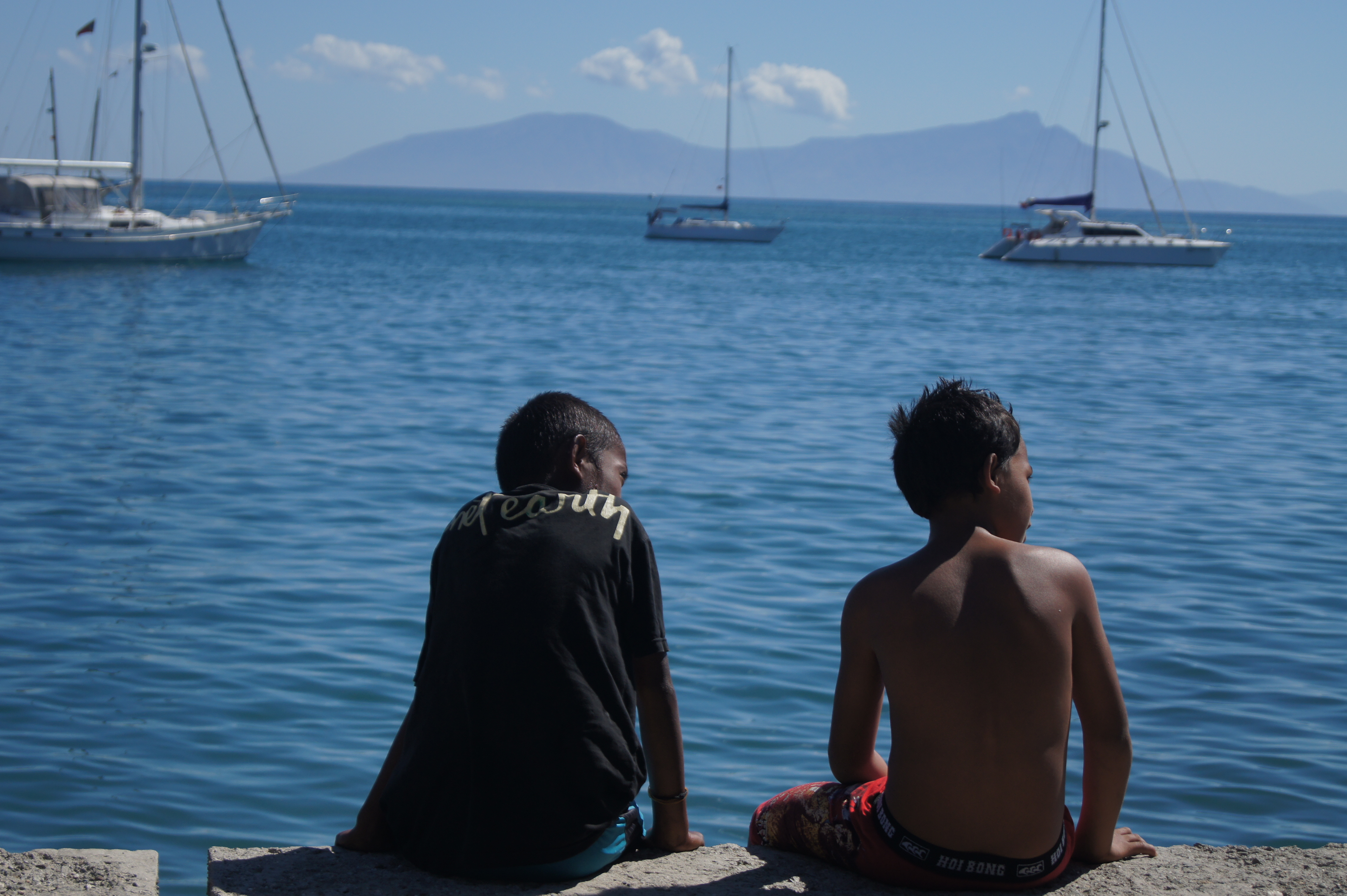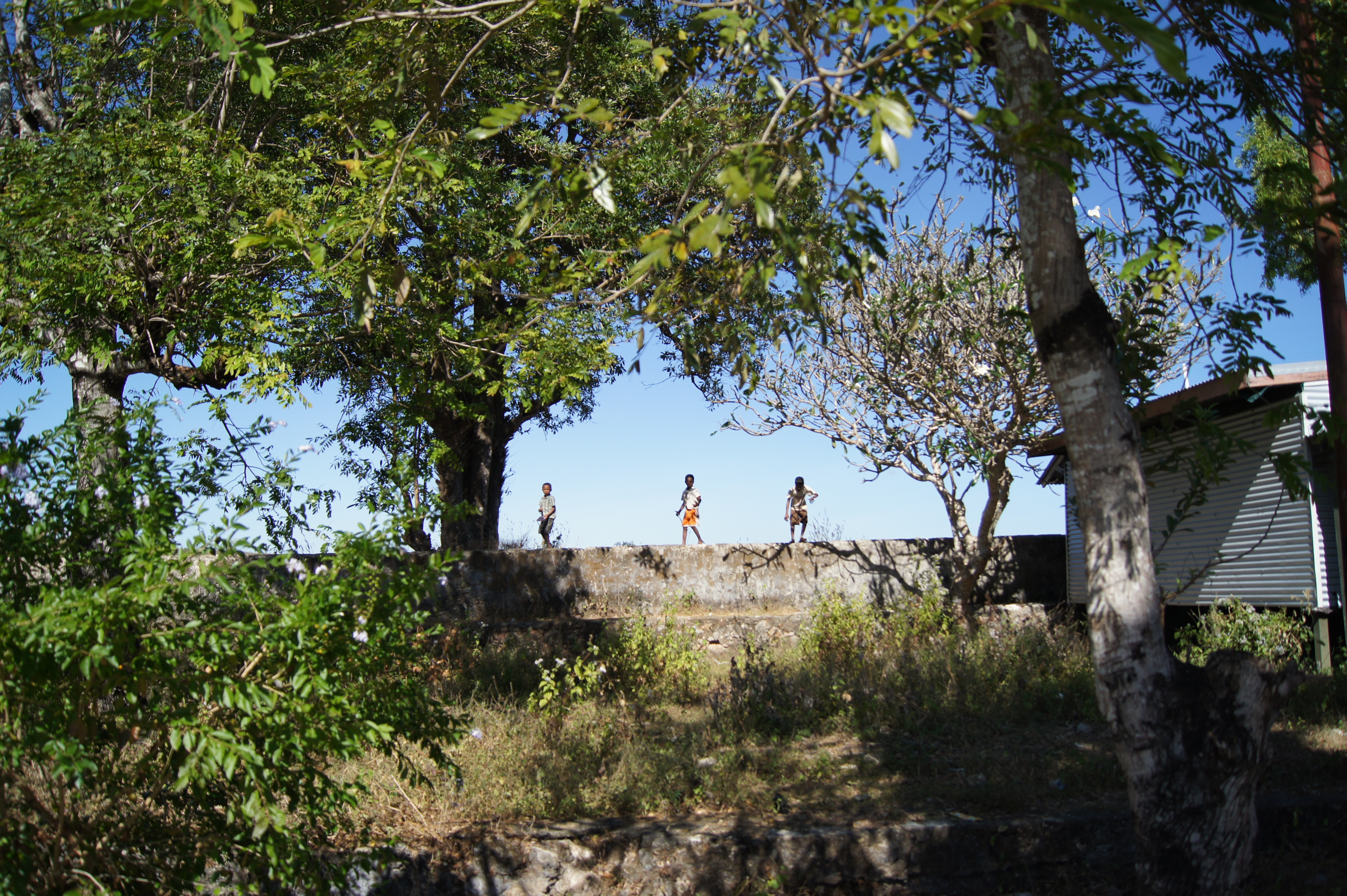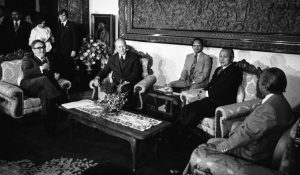The view from the old fortress in Balibo is of the Savu Sea and volcanic slopes consisting of sun-torched branches and eroded soil. Children of war-plagued parents play here, running along the boulders that the Indonesian invaders sprayed with bullets that day in late 1975 when Timor-Leste was overrun by the Indonesian army and pro-Indonesian militias.
The children engage in a game where branches act as rifles and shadows from the trees are invisible enemies that needs to be defeated. Cows dig in the gravel next to the “integration monument” erected by Indonesia in the wake of its completed occupation in 1978. The monument depicts a soldier in mid-war cry, holding a rifle in one hand and an Indonesian flag in the other.

An Indonesian-built “integration monument” erected in the wake of its completed occupation in 1978. Photo by Klas Lundström.
In 1975, the Portuguese empire collapsed following the death of long-lasting despot Antonio de Oliveira Salazar and the democratic revolution in 1974. All “oversea territories” – the title given to all Portuguese colonies – were handed independence. But for the Indonesian dictator General Suharto, the future of Portuguese Timor – situated on the outer edge of the Indonesian archipelago, near the floating triple frontier between Southeast Asia, Melanesia, and Australia – lay in being “integrated” into Indonesia.
“Indonesia’s hostility towards the establishment of an independent East Timor stems from the military regime’s perpetual paranoia over security,” wrote Carmel Budiardjo and Liem Soei Liong in their 1984 classic “The War Against East Timor.” They added, “The prospect of sharing borders with a potentially democratic, non-aligned state was seen from the beginning as a grave threat to its own security.”
Then-U.S. Secretary of State Henry Kissinger agreed. In a declassified memo written prior to then-U.S. President Gerald Ford’s December 1975 visit to Indonesia and meeting with Suharto, Kissinger stated that “a merger with Indonesia is probably the best solution for the colony.”
Timor-Leste, though, had no intention of pursuing “a merger” with Indonesia. The political forces of the former Portuguese colony swiftly outlined its first declaration of independence, dated November 28, 1975, which underscored the newborn nation’s intentions of promoting democracy as “anti-colonialist and anti-imperialist.” Its over 400-year-long dream of self-determination was, however, shattered a little over a week later when the border outpost of Balibo was stormed on December 7.
Henry Kissinger’s “realpolitik” view of Indonesia’s annexation of the former Portuguese colony was deeply rooted in Cold War dialectics and in fear of a potential Chinese entrance to the eastern part of Timor just as the United States had been defeated and ousted from Vietnam. Indonesia was, in the eyes of Kissinger, a stabilizing North Star in a politically turbulent Southeast Asia – a political ally that would turn out to be capable of doing just about anything to protect its domestic soil from progressive seeds.
Kissinger and Ford were well aware of Indonesia’s bloodstained reality under the rule of Suharto, a general whose rise to power in the mid-1960s coincided with U.S.-encouraged politically motivated mass killings of between 500,000 and 1 million Indonesians (and more than 120 documented mass graves) – the vast majority of whom were members of the PKI (the Indonesian Communist Party), union activists, indigenous peoples, or women’s rights champions.

The Timorese countryside, now. Photo by Klas Lundström.
Despite the Suharto regime’s continuous purge of political opponents, Kissinger saw no reason to forestall the predictable bloody outcome of an Indonesian annexation of newly independent Timor-Leste: “We recognize the problem that Timor poses for Indonesia, and we appreciate the restraint that Indonesia has exercised to date,” Kissinger wrote as a “talking point” in a memo to Ford. The “problem” that the newly independent Timor-Leste posed for Suharto was rooted, to use the general’s own words, in the fact that its leaders “are infected the same as is the Portuguese army with communism.”
On the eve of the Indonesian invasion, Kissinger told Suharto in person: “It is important that whatever you do succeeds quickly,” although preferably “better if it were done after we returned” to the United States.
The American carte blanche to Indonesia regarding Timor was never intended to be deciphered and presented to the public, let alone be included in any official history book; it certainly wasn’t mentioned in any shape, whisper, or form in Ford’s 1979-autobiography “A Time to Heal.” Nevertheless, Indonesia’s reliance on American assurances and blessings, and its need of American military equipment, were of utmost importance, which is why it’s quite telling that the U.S. presidential plane, Air Force One, made sure to be heading for politically safer shores, in Hawaiʻi, by the time of Indonesia’s invasion.
The conversation between Suharto, Ford, and Kissinger in Jakarta on the eve of the Indonesian invasion hinted at the media distraction to be pulled off by the three politicians. Kissinger told Suharto, “If you have made plans, we will do our best to keep everyone quiet until the President returns home.”
The New York Times, via The Associated Press, was among those media outlets to republish the political smokescreen sent out by Ford’s spin doctors after the meeting with Suharto: “President Ford sought to reassure the Government of Indonesia today [December 6, 1975] that the United States continued to be committed to the ‘peace and security’ of Southeast Asia.” A joint communiqué from Ford and Suharto underlined the United States’ intention to continue “to provide substantial aid to Indonesia in support of Indonesia’s development efforts.”
The initial Balibo invasion resulted in numerous civilian casualties. But the killing started even earlier, on October 16, 1975, with the assassinations of five Western journalists who were trying to document the looming illegal invasion. They later came to be known as the “Balibo Five.” Another journalist who traveled to the region to investigate the murders was captured on December 7 and executed by Indonesian forces the following day in Dili
As the Indonesian invasion pushed farther east, the casualty tally grew and reached genocidal proportions less than a year later. Despite Indonesia having sealed the borders to its newest “province,” embedded reporters were still able to publish startling images of starved and stunted children in Indonesian-run concentration camps. (The Red Cross wasn’t granted access until 1981.) Not even Indonesia’s then-Secretary of State Adam Malik shied away from the high numbers of slayed Timorese civilians, when interviewed in 1977: “50,000 people or perhaps 80,000 might have been killed during the war in Timor… What is the big fuss… It was war.”
It was a war fueled by arms sales from Western powers to the Indonesian army, and an ongoing genocide ignored by the international community and the media.

Children playing in Dili harbor. Photo by Klas Lundström.
According to research conducted by historian Gabriel Defert, more than 300,000 people lost their lives as a result of the Indonesian takeover between 1975 and 1981, around 44 percent of the entire 1975 population of 630,000. “This makes the death toll in East Timor the highest relative to total population since the Holocaust,” Indonesian journalist Andreas Harsono wrote in his book “Race, Islam, and Power.”
In eastern Timor-Leste, along the slopes of Matebian (Tetum for “The Mountain of the Dead”), people still talk of unmarked and undisclosed mass graves, filled up with murdered civilians during the Indonesian army’s final swoop against the Timorese resistance movement in 1978. “On Matebian, we lived with the dead,” Xanana Gusmão, Timor-Leste’s first independent president and one of its military commanders, told journalist Irena Cristalis in “A Nation’s Bitter Dawn.”
In the mountains, all access to food and water was lost. Lands were either abandoned or demolished in the bomb raids. “If only we had a camera and could show the world pictures, or a foreign journalist, who could tell our story,” Gusmão recalled, remembering the starved and carved-out faces refusing to surrender to the Indonesian occupiers. When the last of the resistance finally surrendered in 1978, it was due to Napalm bombs and the use of chemical weapons. The surrendered ended up in concentration camps or in prison.
“We keep living with the dead around here; we can’t escape them” a former underground member of the resistance movement told me while pointing toward the slopes of Matebian. “All Timorese families have lost someone or were entirely destroyed. There’s no forgiving that. We still don’t understand why the so-called democratic countries allowed Suharto to do what he did with us.”

The road leading to Mount Matebian. Photo by Klas Lundström.
The man, who told me he’d lost his name and sense of belonging along with the Indonesian invasion, continued his walk along gravel roads and fields along the mountain slopes, every now and then pointing to the ground, saying, “Another massacre occurred here, there’s a mass grave, a lot of children were buried over there.” Many who disappeared remain unaccounted for. Relatives have no information about the whereabouts of their loved ones, nor their fates.
As the war-torn, famine-struck, and decimated Timorese population entered the long night of Indonesian occupation – which finally ended when Suharto resigned in 1998 and paved the way for independence after a referendum in 1999 – Henry Kissinger had already moved on. He kept his ears and nose close to the ground, though, and advised and encouraged Latin American dictatorships in their anti-communist crusades while making money as a consultant and businessman.
The scars of the Indonesian invasion run deep into the Timorese body politic. Many wounds continue to bleed. Fifty percent of Timor-Leste’s children under five years old are stunted due to malnutrition and a collective post-traumatic stress disorder and severe distress have remained hanging over the Timorese population like a haunting cloud.
The United States has, like no other society, “more firmly insisted on the inadmissibility of intervention in the domestic affairs of other states, or more passionately asserted that its own values were universally applicable,” wrote Henry Kissinger in “Diplomacy,” in 1994. He added that “America serves its values best by perfecting democracy at home, thereby acting as a beacon for the rest of mankind.”
In Timor-Leste, that beacon lit the way to genocide.

Children stand on a wall from which the Balibo Five spotted Indonesian troops landing, witnessing incursions months ahead of the invasion. Photo by Klas Lundström. Photo by Klas Lundström.

































